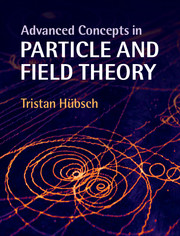Book contents
- Frontmatter
- Epigraph
- Contents
- Preface
- I Preliminaries
- II The Standard Model
- 3 Physics in spacetime
- 4 The quark model: combinatorics and groups
- 5 Gauge symmetries and interactions
- 6 Non-abelian gauge symmetries and interactions
- 7 The Standard Model
- III Beyond the Standard Model
- IV Appendices
- A Groups: structure and notation
- B A lexicon
- C A few more details
- References
- Index
6 - Non-abelian gauge symmetries and interactions
from II - The Standard Model
- Frontmatter
- Epigraph
- Contents
- Preface
- I Preliminaries
- II The Standard Model
- 3 Physics in spacetime
- 4 The quark model: combinatorics and groups
- 5 Gauge symmetries and interactions
- 6 Non-abelian gauge symmetries and interactions
- 7 The Standard Model
- III Beyond the Standard Model
- IV Appendices
- A Groups: structure and notation
- B A lexicon
- C A few more details
- References
- Index
Summary
The previous chapter showed how the fact that the phase of the electron wave-function is not an observable quantity leads to the concept of gauge symmetry, which in turn introduces the gauge potentials, and which then provides the basic framework for describing gauge interactions. The chapter before that showed that the classification of mesons and hadrons in the quark model uncovers that quarks have an additional degree of freedom – dubbed color, and the corresponding symmetry with the structure of the SU(3)c group. Since the physical states that may be detected must be “colorless,” i.e., SU(3)c-invariant, it follows that the color of any individual quark cannot be detected either, and so can be changed arbitrarily. This arbitrariness – as a function of space and time! – of the color change in quarks while maintaining the hadron composed of those quarks “colorless” is the essence of the so-called gauge principle. When applied to the local changes in the (matrix-valued) phases of wave-functions, the resulting theories are called “Yang–Mills theories” Chapter 9 will show that the application of the same idea to local changes of parametrization of the spacetime itself leads to Einstein's theory of gravity.
6.1 The gauge symmetry of color
The first non-abelian (non-commutative) gauge theory was proposed by Oskar Klein in 1938, but that proposal was too early and remained undeveloped, unapplied, and forgotten. Non-abelian gauge theories were taken seriously only after 1954–5, after the publication of the works of C.-N. Yang and R. L. Mills, and independently, R. Shaw's dissertation mentored by A. Salam. However, both of the (currently) well-known applications, the SU(2)w theory of weak nuclear interactions and the SU(3)c theory of strong nuclear interactions, required several decades of development and novel ideas for a general acceptance and contemporary formulation of these theories, as well as their embedding in the “Standard Model.”
The next few sections consider the SU(3)c gauge theory as a theoretical system for describing strong nuclear interactions.
- Type
- Chapter
- Information
- Advanced Concepts in Particle and Field Theory , pp. 223 - 250Publisher: Cambridge University PressPrint publication year: 2015

